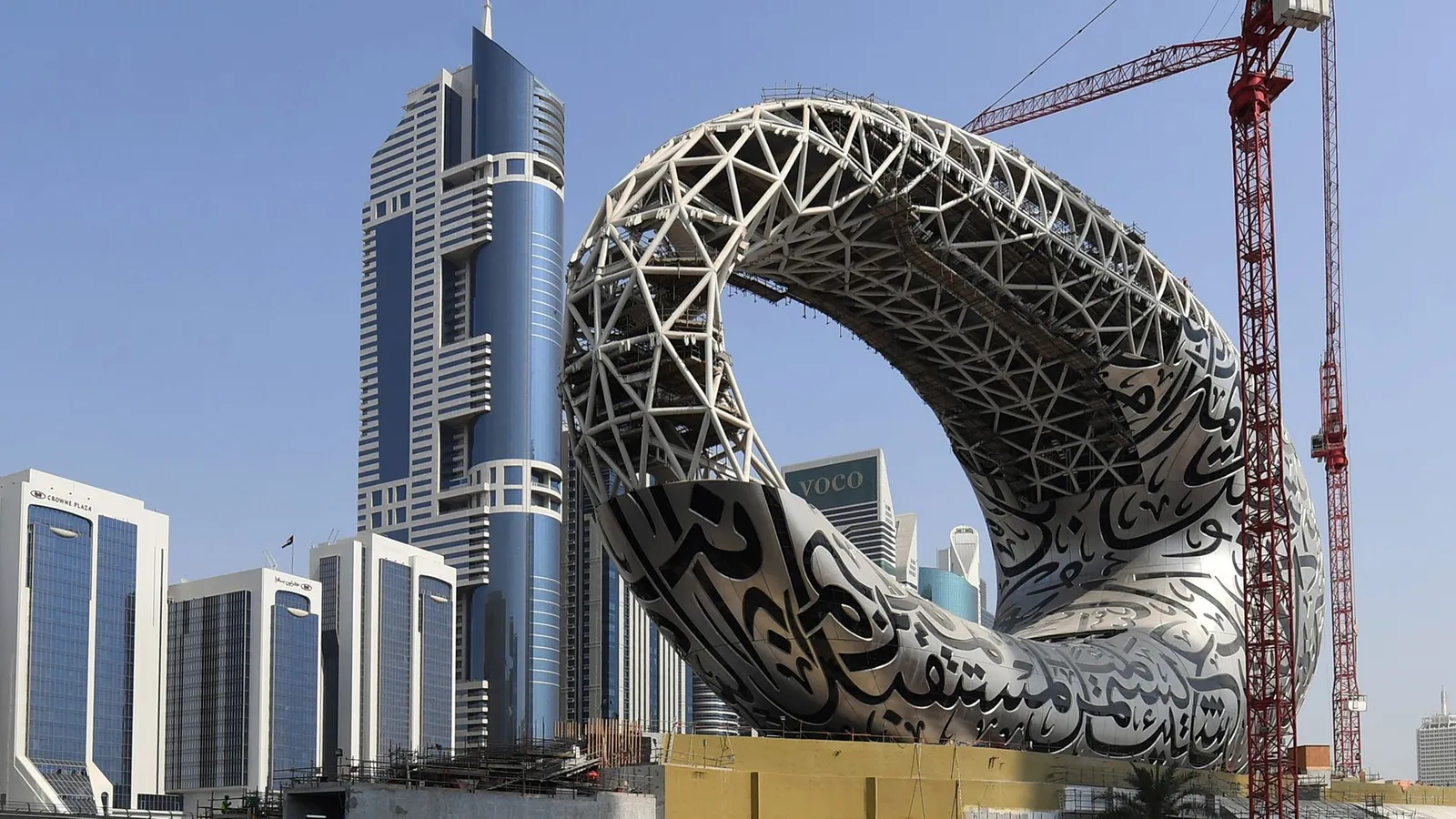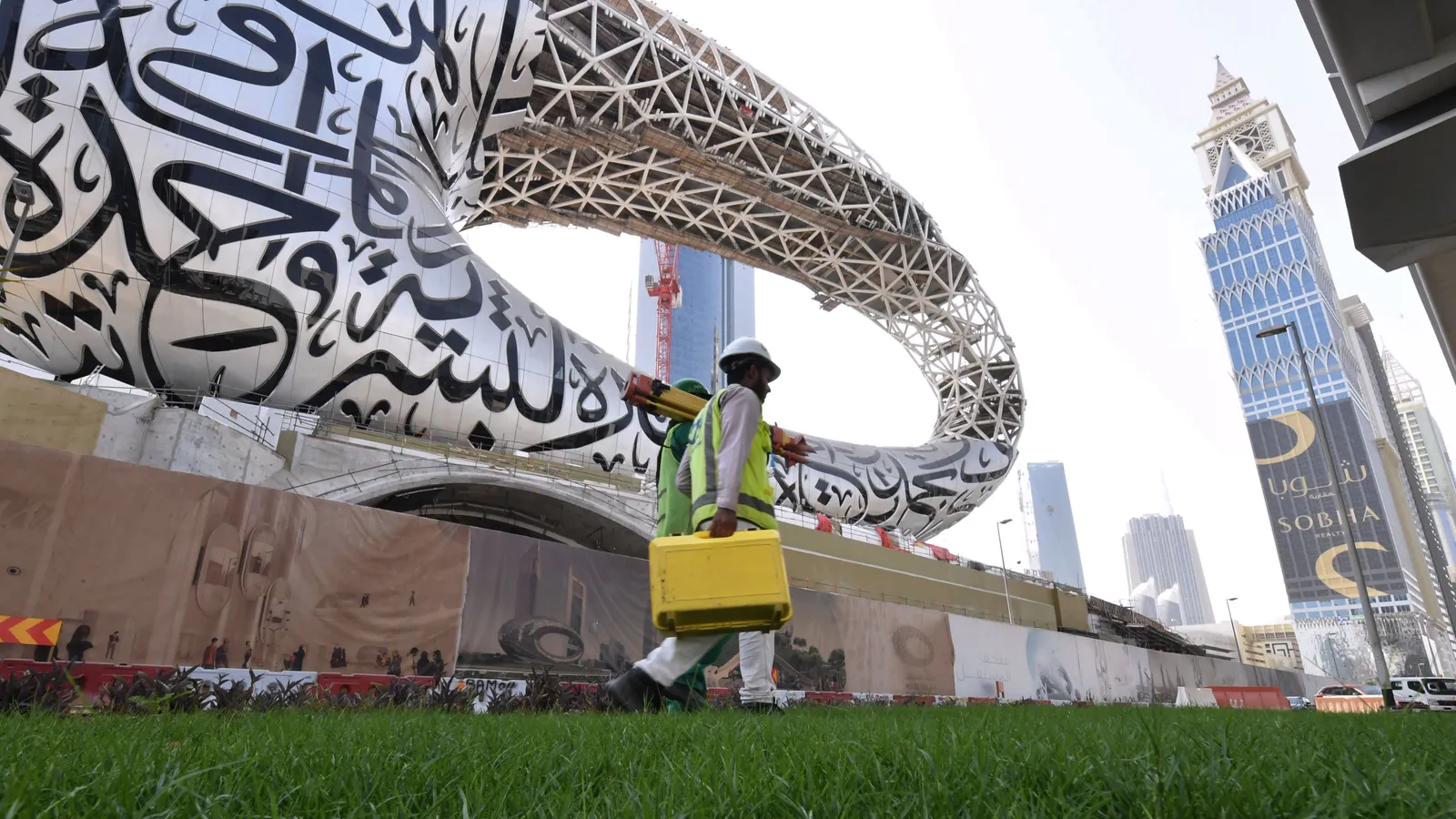Dr. N. Subramanian
General Sponsor


Joined: 21 Feb 2008
Posts: 5524
Location: Gaithersburg, MD, U.S.A.
|
 Posted: Mon Mar 07, 2022 8:35 pmPost subject: Museum of Future, Dubai-An Iconic unique asymmetric torus Posted: Mon Mar 07, 2022 8:35 pmPost subject: Museum of Future, Dubai-An Iconic unique asymmetric torus |
 |
|
Museum of Future, Dubai
Dubai�s Newest Architectural Marvel was opened to the public on February 22. The choice of the date was officially made because the 22nd of February 2022 is the Palindrome date.

The Museum of Future, was designed as an unique asymmetric torus by by Dubai-based studio Killa Design (headed by architect Shaun Killa) and engineered by Buro Happold. The Museum of the Future has three main elements: green hill, building, and void, and was founded by the Dubai Future Foundation. According to the architect, the solid part of the structure represents the knowledge that we have today and the void represents all that we do not yet know � in other words, the future.
建筑的目的是获得李D Platinum rating for its green technology. Danem Engineering Works was one of the steel structure contractors for the project.
The museum�s framework, comprising 2,400 diagonally intersecting steel members, was completed in November 2018; after that the facade panels were lifted into place. This torus-shaped shell sits at the top and consists of 1,024 fire-retardant composite panels clad in stainless steel, and each of which has a unique 3D shape to create the Arabic script (see Photo).
Killa Design and Buro Happold developed new parametric design and Building Information Modelling (BIM) tools, including a growth algorithm to digitally develop the internal steel structure (Parametric design is a process based on an algorithm, which allows specific variables or parameters to be manipulated to alter the outcome of an equation. As we know, BIM is a three-dimensional model-based technology for construction professionals to collaboratively design and document projects).
The first computational task for Buro Happold was to fine-tune the theoretical shape of the building in order to smooth out complex curvatures. These millimetric alterations, undetectable to the eye, took a long time to finalize, and removed a host of complications. Buro Happold than took up the design of the steel framework, known as a diagrid (the diagonally intersecting beams), and the lightweight fa�ade. This lightweight fa�ade was chosen as the most practicable solution, instead of a steel or concrete shell, because of the shape and complexity of the building.
With endless possible permutations for the diagrid, BuroHappold wrote its own growth algorithm to arrive at the optimal arrangement. The result was a diagrid that was optimized in terms of the number of joints, the diameter of the steel tubes, and even the total weight of steel used. According to BuroHappold, this optimal arrangement resulted in cost and time savings for the client, contractors and fabricators.
Contractor Bam Higgs & Hill and structural steel fabricator Eversendai Engineering then conducted the construction sequencing analysis and connection design for the structure, taking into account the shifting stresses and loads during the erection process, before moving ahead with construction.

The building would have been an impossible undertaking without the help of new, sophisticated technologies (Credit: Getty Images)
Having built the reinforced concrete ring beam and tower that support the diagrid, it took 14 months to complete the steel work. Throughout the construction process, laser scanning was used to compare the as-built positions with the 3D model. Coordination of the MEP engineering began much earlier in the project, due to the working with 2D drawings which should translated to 3D models and to resolve any problems long before work moved onsite. Laser projections of the BIM models also helped.
Because of the geometry of the seven-story building and the calligraphy cut-outs, no two fiberglass panels are alike. Each of the 1,024 panels had to be individually moulded and manufactured before the addition of the stainless steel finish and the glazing. Due to this hugely labor-intensive process only up to six panels could be manufactured in a day. It took a year of experimentation for the fa�ade supplier Affan to develop the panel structure and design, and to prototype the production processes, which included computer-controlled machining tools.

Each of the 1,024 panels is unique and requires complex engineering before it even arrives at site (Credit: Getty Images)
The glazing units were also unique pieces, as they combined with adjacent panels to form the free-flowing calligraphy. Parametric scripting was used to determine the final position and size of the lettering to find the optimum balance between the amount of natural light entering the museum, the solar heat gain, the air conditioning load and the aesthetics. All these points were considered, while also achieving the points needed for the museum to be rated a LEED Platinum building. As with the steel work, an enormous effort went into programming the sequencing of the panel installation. Some of the more complex pieces took two or three days to install.

The exhaustive 3D modelling also removed the typical problems associated with the mechanical, electrical and plumbing (MEP) installation.
Designed as an unique asymmetric torus clad in steel and covered in poetry by Sheikh Maktoum, the late vice president and prime minister of the United Arab Emirates, the museum envisages the world in 2071. The Museum of the Future has already been recognized by the National Geographic as one of 14 most beautiful museums in the world.
The museum is just off Dubai�s main thoroughfare, Sheikh Zayed Road. Surrounded by dozens of skyscrapers, it represent Dubai�s vision of the future.
The museum's striking exterior also stands out thanks to its artistic use of Arabic calligraphy, which functions as glass windows too. Designed by Emirati artist Mattar bin Lahej, they reflect lines of inspirational poetry by HH Sheikh Mohammed bin Rashid Al Maktoum, Vice President and Prime Minister of the UAE and Ruler of Dubai. The three quotes enveloping the fa�ade translates to: �We won't live for hundreds of years, but we can create something that will last for hundreds of years.
The future will be for those who will be able to imagine, design and build it, the future does not wait, the future can be designed and built today. The secret of the renewal of life, the development of civilization and the progress of humanity is in one word: innovation.�

The 890 stainless-steel-clad glass fiber reinforced plastic (GFRP) forms the building�s landmark fa�ade. Image: Phil Handforth
Greener future
From the outset, it was determined that the Museum of the Future would aim for a LEED Platinum rating. The building is equipped with advanced building control solutions, greywater recycling systems and regenerative drive lifts, while its power needs is met through photovoltaic solar arrays located offsite. Visitors can charge their electric vehicles while touring the museum and the number of car parking spaces is limited to encourage the use of public transport. In addition, the museum restricts single use plastic.
What to expect at Museum of the Future
The museum has seven floors dedicated to different exhibitions. Three floors focus on outer space resource development, ecosystems and bioengineering, and health & wellbeing. The other floors showcase near-future technologies that address challenges in areas including health, water, food, transportation, and energy, while the last floor is dedicated to children. it is packed with lucid interactive displays relating to earth, outer space, the mind, body, and spirit.
Furthering a global intellectual movement, it's also the headquarters for the city's �Great Arab Minds� initiative that aims to identify 1,000 exceptional Arab talents across key fields.
The museum�s exhibitions also emphasize sustainability. The museum addresses the effect of global warming on critical ecosystems and how these might be repaired. It also looks at how solar energy collection in space and asteroid mining could be used for the benefit of humanity, and even touches upon the subject of spirituality.

被称为“活的博物馆”,它包含的元素of traditional exhibitions, immersive theatre and themed attractions, so visitors can look beyond the present and towards the future's limitless possibilities. Visitors will have the chance to engage with this game-changing technology.
The museum will host innovation labs dedicated to several sectors, including health, education, smart cities, energy and transport. It will also support and test new inventions in partnership with research institutes and universities.
Each floor of the museum is designed like an expansive, interactive movie set, brought to life by expert storytellers, technologists and visionary artists. Aside from ground-breaking innovations, there will also be special workshops and talks from the world's greatest minds.

Children aged three to 10 can enjoy an open-world experience at the Future Heroes environment, a dedicated area designed to encourage little ones to tap into their potential.
Visitors to the museum begin by taking an elevator to a makeshift space station. Looking out over earth, they are presented with a problem: the earth is sick. Each visitor is then given a role to play (doctor, teacher) and tasked with unpacking the world�s problems.
According to Brendan McGetrick, the museum�s creative director, providing that kind of immersive experience is exactly what makes the institution unique.
The Museum of the Future is hoping to attract more than one million visitors a year, with half coming from outside the UAE.
Do you want to visit it? Check:https://museumofthefuture.ae/en/book;门票售价AED145以下儿童the age of three, people of determination and Emirati senior citizens receive complimentary entry.
引用:
https://www.bbc.com/future/article/20191028-museum-of-the-future-the-building-designed-by-an-algorithm
https://www.burohappold.com/projects/museum-of-the-future/#
https://en.wikipedia.org/wiki/Museum_of_the_Future |
|